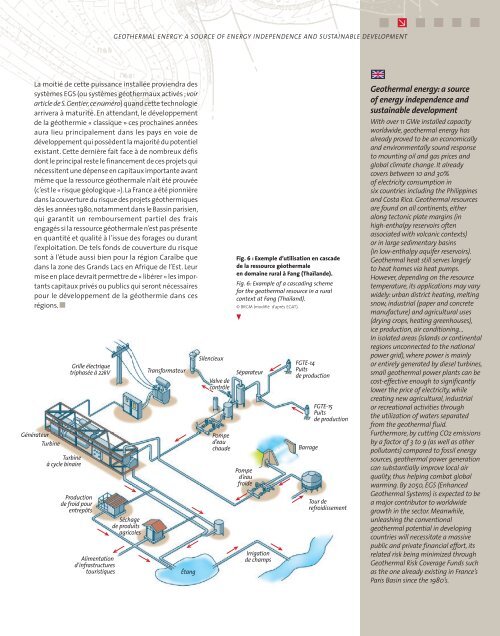revue_geosciences16
revue_geosciences16
revue_geosciences16
You also want an ePaper? Increase the reach of your titles
YUMPU automatically turns print PDFs into web optimized ePapers that Google loves.
geothermal energy: a source of energy independence and sustainable development<br />
La moitié de cette puissance installée proviendra des<br />
systèmes EGS (ou systèmes géothermaux activés ; voir<br />
article de S. Gentier, ce numéro) quand cette technologie<br />
arrivera à maturité. En attendant, le développement<br />
de la géothermie « classique » ces prochaines années<br />
aura lieu principalement dans les pays en voie de<br />
développement qui possèdent la majorité du potentiel<br />
existant. Cette dernière fait face à de nombreux défis<br />
dont le principal reste le financement de ces projets qui<br />
nécessitent une dépense en capitaux importante avant<br />
même que la ressource géothermale n’ait été prouvée<br />
(c’est le « risque géologique »). La France a été pionnière<br />
dans la couverture du risque des projets géothermiques<br />
dès les années 1980, notamment dans le Bassin parisien,<br />
qui garantit un remboursement partiel des frais<br />
engagés si la ressource géothermale n’est pas présente<br />
en quantité et qualité à l’issue des forages ou durant<br />
l’exploitation. De tels fonds de couverture du risque<br />
sont à l’étude aussi bien pour la région Caraïbe que<br />
dans la zone des Grands Lacs en Afrique de l’Est. Leur<br />
mise en place devrait permettre de « libérer » les importants<br />
capitaux privés ou publics qui seront nécessaires<br />
pour le développement de la géothermie dans ces<br />
régions. ■<br />
Générateur<br />
Turbine<br />
Turbine<br />
à cycle binaire<br />
Grille électrique<br />
triphasée à 22kV<br />
Production<br />
de froid pour<br />
entrepôts<br />
Alimentation<br />
d’infrastructures<br />
touristiques<br />
Séchage<br />
de produits<br />
agricoles<br />
Transformateur<br />
Étang<br />
Silencieux<br />
Valve de<br />
contrôle<br />
Pompe<br />
d’eau<br />
chaude<br />
Fig. 6 : Exemple d’utilisation en cascade<br />
de la ressource géothermale<br />
en domaine rural à Fang (Thaïlande).<br />
Fig. 6: Example of a cascading scheme<br />
for the geothermal resource in a rural<br />
context at Fang (Thaïland).<br />
© BRGM (modifié d’après EGAT).<br />
Séparateur<br />
Pompe<br />
d’eau<br />
froide<br />
Irrigation<br />
de champs<br />
FGTE-14<br />
Puits<br />
de production<br />
Barrage<br />
FGTE-15<br />
Puits<br />
de production<br />
Tour de<br />
refroidissement<br />
Geothermal energy: a source<br />
of energy independence and<br />
sustainable development<br />
With over 11 GWe installed capacity<br />
worldwide, geothermal energy has<br />
already proved to be an economically<br />
and environmentally sound response<br />
to mounting oil and gas prices and<br />
global climate change. It already<br />
covers between 10 and 30%<br />
of electricity consumption in<br />
six countries including the Philippines<br />
and Costa Rica. Geothermal resources<br />
are found on all continents, either<br />
along tectonic plate margins (in<br />
high-enthalpy reservoirs often<br />
associated with volcanic contexts)<br />
or in large sedimentary basins<br />
(in low-enthalpy aquifer reservoirs).<br />
Geothermal heat still serves largely<br />
to heat homes via heat pumps.<br />
However, depending on the resource<br />
temperature, its applications may vary<br />
widely: urban district heating, melting<br />
snow, industrial (paper and concrete<br />
manufacture) and agricultural uses<br />
(drying crops, heating greenhouses),<br />
ice production, air conditioning...<br />
In isolated areas (islands or continental<br />
regions unconnected to the national<br />
power grid), where power is mainly<br />
or entirely generated by diesel turbines,<br />
small geothermal power plants can be<br />
cost-effective enough to significantly<br />
lower the price of electricity, while<br />
creating new agricultural, industrial<br />
or recreational activities through<br />
the utilization of waters separated<br />
from the geothermal fluid.<br />
Furthermore, by cutting CO2 emissions<br />
by a factor of 3 to 9 (as well as other<br />
pollutants) compared to fossil energy<br />
sources, geothermal power generation<br />
can substantially improve local air<br />
quality, thus helping combat global<br />
warming. By 2050, EGS (Enhanced<br />
Geothermal Systems) is expected to be<br />
a major contributor to worldwide<br />
growth in the sector. Meanwhile,<br />
unleashing the conventional<br />
geothermal potential in developing<br />
countries will necessitate a massive<br />
public and private financial effort, its<br />
related risk being minimized through<br />
Geothermal Risk Coverage Funds such<br />
as the one already existing in France’s<br />
Paris Basin since the 1980’s.












